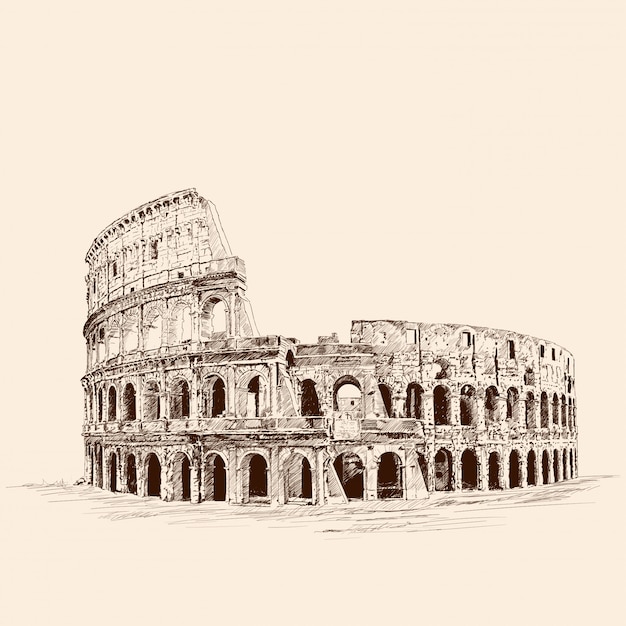Step into the world of art and architecture as we embark on a journey to capture the iconic Colosseum through the medium of pencil sketching. This informatical article will provide you with a step-by-step guide to create a stunning pencil sketch of the Colosseum, allowing you to bring the ancient amphitheater to life on paper.
The Colosseum, a symbol of ancient Rome’s grandeur, stands as a testament to human ingenuity and architectural prowess. With its vast elliptical structure and intricate details, it beckons artists to capture its beauty and majesty. In this article, we will delve into the techniques and skills required to create a realistic and compelling pencil sketch of the Colosseum.
Before we delve into the detailed steps, let’s gather the necessary materials. You will need a set of graphite pencils of varying grades, an eraser, a sharpener, a ruler, and a sketchbook. Additionally, reference images of the Colosseum will be helpful to guide your sketch. With these tools in hand, let’s embark on our artistic journey.
Colosseum Pencil Sketch
Capture Rome’s iconic landmark with simple strokes.
- Choose the right tools: Graphite pencils, eraser, sharpener, ruler, sketchbook.
- Study reference images: Understand the Colosseum’s structure and details.
- Start with basic shapes: Outline the Colosseum’s elliptical form, arches, and columns.
- Add details gradually: Work from general to specific, adding layers of shading and texture.
With patience and attention to detail, your pencil sketch will bring the Colosseum’s grandeur to life on paper.
Choose the Right Tools: Graphite Pencils, Eraser, Sharpener, Ruler, Sketchbook
Selecting the appropriate tools is crucial for creating a successful pencil sketch of the Colosseum. Each tool plays a specific role in helping you achieve the desired outcome.
- Graphite Pencils:
Opt for a set of graphite pencils with varying grades, typically ranging from HB to 6B. Harder pencils (H grades) are suitable for light lines and initial sketching, while softer pencils (B grades) are ideal for darker shades and creating depth.
- Eraser:
Choose a good quality kneaded eraser or a white vinyl eraser. Kneaded erasers are gentle and moldable, allowing for precise erasing without damaging the paper. White vinyl erasers provide a cleaner and more thorough erasing action.
- Sharpener:
Keep your pencils sharp using a good quality sharpener. A sharp pencil allows for better control and precision when sketching the details of the Colosseum.
- Ruler:
A ruler is useful for creating straight lines and measuring proportions. It can assist in sketching the Colosseum’s elliptical shape and ensuring accurate placement of arches and columns.
- Sketchbook:
Select a sketchbook with thick, high-quality paper that can withstand multiple erasures and layering of graphite. A sketchbook with a hard cover provides a stable surface for sketching and helps protect your work.
With the right tools in hand, you can confidently embark on your Colosseum pencil sketch, knowing that you have the necessary materials to capture its grandeur and intricate details.
Study Reference Images: Understand the Colosseum’s Structure and Details
Before you start sketching, it’s essential to study reference images of the Colosseum to gain a deep understanding of its structure and intricate details. Reference images will serve as your guide, helping you capture the essence and accuracy of this iconic landmark.
- Find High-Quality Images:
Search for high-resolution images of the Colosseum from various angles. Look for images that showcase the Colosseum’s overall structure, as well as close-ups of its arches, columns, and other architectural elements.
- Analyze the Structure:
仔细观察斗兽场的整体结构。注意它的椭圆形形状、四层拱门、以及支撑拱门的柱子。了解斗兽场的对称性以及拱门和柱子的排列方式。
- Focus on Details:
Pay attention to the intricate details of the Colosseum. Look for decorative elements such as sculptures, friezes, and inscriptions. Observe the texture and質感 of the stone blocks and the weathering effects over time.
- Study Different Perspectives:
Gather reference images taken from different perspectives. This will help you understand the Colosseum’s three-dimensional form and how it appears from various angles. It will also provide you with a wider range of compositional possibilities for your sketch.
By thoroughly studying reference images, you will develop a deep appreciation for the Colosseum’s architectural features and be better equipped to recreate its grandeur and beauty in your pencil sketch.

